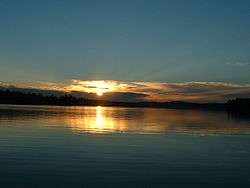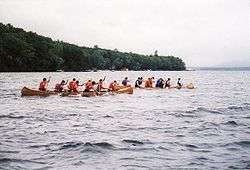YMCA Camp Lawrence
YMCA Camp Lawrence is a residential summer camp for boys located on Bear Island in Lake Winnipesaukee, New Hampshire. It is owned and operated by the Merrimack Valley YMCA, based in Lawrence, Massachusetts. It is the only island-based boys camp in New Hampshire, and one of only several in the country.[1]
The Merrimack Valley YMCA also operates Camp Nokomis, a residential summer camp for girls, also located on Bear Island.
History
The Lawrence YMCA first offered a summer day camp for young boys in 1901 or 1902, but the origins of "Camp Lawrence" as a residential camp can be traced to 1906, with a 10-day program run in Old Orchard Beach, Maine. In late August and early September, 30 boys and 2 adults spent their days engaged in sports, swimming, boating and outings to nearby attractions.[2]
For 8 of the next 9 years, the Lawrence YMCA ran similar camping programs in Maine, New Hampshire and Massachusetts, changing sites nearly every year. The sole year without a summer camp, 1911, was due to the YMCA's move to a new facility and the financial and administrative challenges involved with it. Beginning in 1916, however, the camp found a home at Loon Cove in Alton, New Hampshire, on the shores of Lake Winnipesaukee.
The five years spent at Loon Cove saw tremendous growth. The camping season was expanded to a full 9 weeks, of which 4 weeks were the regular Boys Camp. Boy Scouts, choir boys, and "employed boys" from Lawrence used the facilities for the remainder of the season. The camp purchased its first motor launches for transportation and entertainment on the lake. From 31 boys in 1912, by 1920 the Boys Camp population had grown to 219 - more than the Loon Cove property could comfortably accommodate. In the fall of 1920, a committee from the YMCA, led by George Hamblet, surveyed several island areas before settling on the southern tip of Bear Island. The following spring, Loon Cove was abandoned and all the camp equipment (including the large tents) was transported to the new site.
The tents were erected on wooden platforms on the eastern shore of the property, facing across the lake towards the Ossipee Mountains. Those platforms still serve as the floors of 2 existing cabins in the Middler Unit. Other surviving structures from the early years on Bear Island include the Dining Hall, built in 1923, and the cabin on the western shore, known as West Beach, which dates to lumber operations on the island in the decade before the camp's arrival.
Camp Lawrence has continued to offer young boys summer camping opportunities on Bear Island since 1921.
Facilities

Camp Lawrence occupies 70 acres (28 ha) at the southern tip of Bear Island in Meredith, New Hampshire. The property includes roughly 1.5 miles (2.4 km) of shoreline; nearly a dozen locations along the shore are designated swim areas. Only three are proper beaches, however: East Beach is used for swim lessons, the adjacent Boating Beach hosts sailing and kayaking, and West Beach is home to waterskiing and canoeing.
Two large grassy fields (the larger known as the Senior Ball Field and smaller known as Junior Ball Field due to their respective proximity to the units) are used for field sports. An asphalt basketball court and one clay tennis court also serve as volleyball and dodgeball surfaces as needed. A sand beach volleyball court was added in 2010
A state-of-the-art ropes course, built and maintained by Project Adventure, draws many campers. Twenty elements rise thirty to sixty feet above the ground, including two zip-lines and one unique "swing shot".
The camp has a total of three large camper bathrooms in addition to several other smaller private bathrooms. The largest, and by far nicest, bathroom on camp is the "Bijou". It was recently redone with six toilets, four urinals, and new tiled floors.
A large dining hall can accommodate up to 230 staff and campers at mealtimes. A complete kitchen renovation was completed in 2010. The Hamblet Lodge provides a secondary enclosed program space, used for socials with Camp Nokomis and rainy-day activities. Such activities include the camp favorite of "one ball".
Sixteen camper cabins can house between eight and sixteen campers and two to three staff members. Most all camper cabins have been replaced or renovated within the past fifteen years. Fourteen cabins house the leadership staff and support staff, and a large infirmary houses the two camp nurses.
Two main boats are used for transportation between Camp Lawrence, Camp Nokomis and the Y-Landing Marina on Meredith Neck. The M/V Bear II can transport up to 120 people, while the Weekeepeekee II has a capacity of 27. These boats are used to transport all passengers, luggage, food and garbage on and off the island. Mail is delivered daily, Monday through Saturday, by the U.S. Mailboat M/V Sophie C. In addition, Camp Lawrence owns four smaller motorcraft, a half dozen sailboats, fifteen kayaks and ten canoes. Two canoes are century-old "war canoes" which can hold up to ten people and are used on an annual basis during the camp's "color wars" and other special activities.
Camp program

Each session, boys camp serves roughly 150 campers between the ages of eight and fifteen. It runs for eight weeks, in four two-week sessions. Session breaks are on alternate Saturdays. Roughly one-third of all campers attend for longer than one session; a handful stay for the full summer.
Ten or eleven days of each session are devoted to regular activities. All boys take daily swim lessons, and they choose four other activities to complete their day. Available activities are waterskiing, canoeing, sailing, kayaking, snorkeling, ropes course, archery, riflery, soccer, basketball, flag football, rugby, campcraft, theatre, volleyball, fitness, Frisbee, general sports, ping pong, fishing, arts and crafts, tennis, lacrosse, and floor hockey
Two or three days of each session are used for special programs. The most popular are the camp Olympics, held each year during the fourth session, and Orange & Grey, the camp color war held each year during the second session. The highlight of Olympics is Tableaux, the opening ceremony. Tableaux is a form of living statue, accompanied by music and text, in which a team of a dozen staff members is covered in aluminum paint and performs stationary and kinetic poses. Orange & Grey ends each year with the Omnibus, a 2-hour relay culminating in a 9-man war canoe race. Other special programs change from year to year; popular programs have included Fourth of July Activities (varying annually), Various Active Games In Natural Areas, Cinco de July-o, Zombie Apocalypse, Wild Wild West Day, King Neptune Day, Treasure Hunt, Up All Night, and Gak Night.
Every session the camp will hold a special evening activity replacing one of the daily cabin or unit nights. These are a favourite of camp and vary by session. Some special nights include: Build Your Own Boat, DeRiemer Night (a night for campers to choose and participate in any activity of their choosing), and Casino Night.
Boys camp is followed by a week-long Family Camp, in which families rent cabins and activity areas are open on a more flexible basis. Family Camp has been run since 1961, and some families have returned each summer for over forty years.[3]
Staff
At the age of 15, campers are eligible to become counselors-in-training, or CITs. In order to apply for the CIT program, campers must receive written recommendations from staff members 18 years of age or older. Staff members assigned to the Senior Unit then rank the applicants among all others who apply for the program. Most years, between 50 to 80 names are submitted with 12 to 15 chosen by the camp director for the selective program. The two-year CIT program guides campers in the transition to staff members. 90 to 95 percent of the program staff each year is composed of graduates of the CIT program, and almost all leadership positions are filled with former CITs. Camp Lawrence is one of the few remaining camps whose leadership staff is made up entirely of former campers.
The remainder of the program staff, as well as many of the support staff, is made up of international staff members hired through BUNAC, Camp America, and CCUSA.
Camp Lawrence was directed by David Carter Hetherly from 1994 to 2010. Hetherly was a former camper and staff member who, after a career in the Army and the private sector, returned to camp to keep busy in retirement.
Alumni support
Camp Lawrence Alumni provide valuable support in finances and time. The Bear Island Camps Association organizes alumni efforts to help both Camp Lawrence and Camp Nokomis. BICA also inducts important volunteers into its Hall of Fame at Alumni Day, held the first Sunday of August each year on Bear Island.
Among the most important alumni are the Hamblet family, whose involvement dates to the purchase of the Bear Island property in 1920. The Hamblets now own the Y-Landing Marina, where the camp boats dock on the mainland. The services the family has provided through the years have been incalculable.
External links
References
- ↑ http://www.acacamps.org American Camping Association website
- ↑ Craig, Jon R., ed. Camp Lawrence: 1906-1982. Self-published: 1983.
- ↑ Merselis, Jack, ed. Bear Island Reflections. Bear Island Conservation Association. Vicks Lithograph, 2000.
Coordinates: 43°38′0″N 71°23′15″W / 43.63333°N 71.38750°W